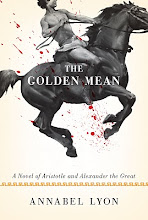Philip II, Alexander the Great's father, was buried in the ancient city of Aegeae, near the modern village of Vergina. The tombs were discovered in 1977 by the Greek archaeologist Manolis Andronikos. The tombs were a rich find: amonst the many precious objects recovered there were Philip's armour, weapons, and marble sarcophogus containing a golden box, or larnax. The larnax held Philip's ashes and a wreath of three hundred and thirteen golden oak leaves and sixty-eight golden acorns.
Aegeae is a UNESCO World Heritage Site. The UNESCO website asserts, in part, that "the site is of outstanding universal value representing an exceptional testimony to a significant development in European civilization, at the transition from classical city-state to the imperial structure of the Hellenistic and Roman periods". To see the website for the museum at Vergina, click here.
This short video clip offers a brief look at the remains of Aegeae and some of the artifacts discovered there, including the Philip's larnax and gold wreath.
12 or 20 (second series) questions with Lorne Daniel
15 hours ago

No comments:
Post a Comment